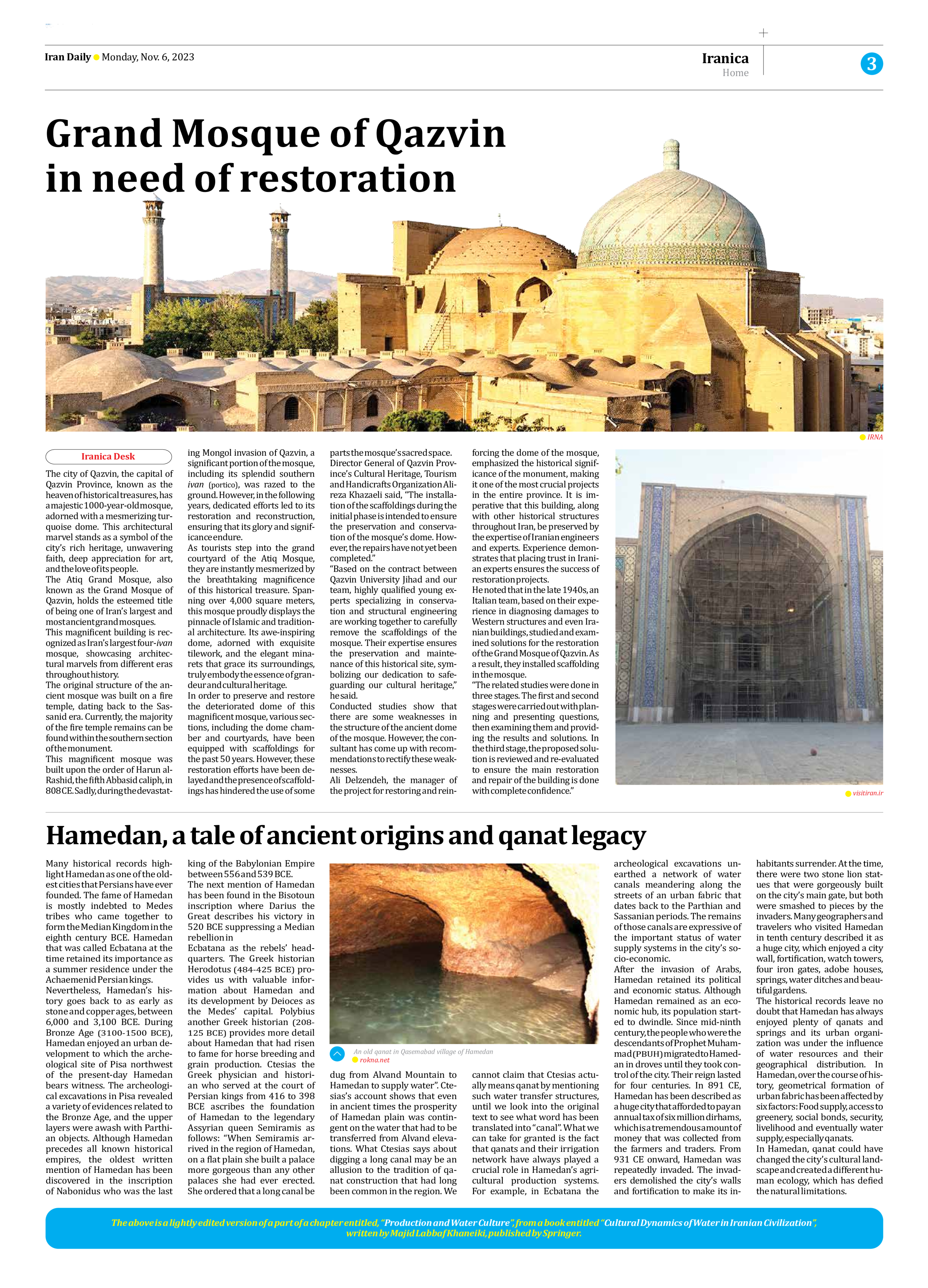
Hamedan, a tale of ancient origins and qanat legacy
Many historical records highlight Hamedan as one of the oldest cities that Persians have ever founded. The fame of Hamedan is mostly indebted to Medes tribes who came together to form the Median Kingdom in the eighth century BCE. Hamedan that was called Ecbatana at the time retained its importance as a summer residence under the Achaemenid Persian kings.
Nevertheless, Hamedan’s history goes back to as early as stone and copper ages, between 6,000 and 3,100 BCE. During Bronze Age (3100-1500 BCE), Hamedan enjoyed an urban development to which the archeological site of Pisa northwest of the present-day Hamedan bears witness. The archeological excavations in Pisa revealed a variety of evidences related to the Bronze Age, and the upper layers were awash with Parthian objects. Although Hamedan precedes all known historical empires, the oldest written mention of Hamedan has been discovered in the inscription of Nabonidus who was the last king of the Babylonian Empire between 556 and 539 BCE.
The next mention of Hamedan has been found in the Bisotoun inscription where Darius the Great describes his victory in 520 BCE suppressing a Median rebellion in
Ecbatana as the rebels’ headquarters. The Greek historian Herodotus (484-425 BCE) provides us with valuable information about Hamedan and its development by Deioces as the Medes’ capital. Polybius another Greek historian (208-125 BCE) provides more detail about Hamedan that had risen to fame for horse breeding and grain production. Ctesias the Greek physician and historian who served at the court of Persian kings from 416 to 398 BCE ascribes the foundation of Hamedan to the legendary Assyrian queen Semiramis as follows: “When Semiramis arrived in the region of Hamedan, on a flat plain she built a palace more gorgeous than any other palaces she had ever erected. She ordered that a long canal be dug from Alvand Mountain to Hamedan to supply water”. Ctesias’s account shows that even in ancient times the prosperity of Hamedan plain was contingent on the water that had to be transferred from Alvand elevations. What Ctesias says about digging a long canal may be an allusion to the tradition of qanat construction that had long been common in the region. We cannot claim that Ctesias actually means qanat by mentioning such water transfer structures, until we look into the original text to see what word has been translated into “canal”. What we can take for granted is the fact that qanats and their irrigation network have always played a crucial role in Hamedan’s agricultural production systems. For example, in Ecbatana the archeological excavations unearthed a network of water canals meandering along the streets of an urban fabric that dates back to the Parthian and Sassanian periods. The remains of those canals are expressive of the important status of water supply systems in the city’s socio-economic.
After the invasion of Arabs, Hamedan retained its political and economic status. Although Hamedan remained as an economic hub, its population started to dwindle. Since mid-ninth century, the people who were the descendants of Prophet Muhammad (PBUH) migrated to Hamedan in droves until they took control of the city. Their reign lasted for four centuries. In 891 CE, Hamedan has been described as a huge city that afforded to pay an annual tax of six million dirhams, which is a tremendous amount of money that was collected from the farmers and traders. From 931 CE onward, Hamedan was repeatedly invaded. The invaders demolished the city’s walls and fortification to make its inhabitants surrender. At the time, there were two stone lion statues that were gorgeously built on the city’s main gate, but both were smashed to pieces by the invaders. Many geographers and travelers who visited Hamedan in tenth century described it as a huge city, which enjoyed a city wall, fortification, watch towers, four iron gates, adobe houses, springs, water ditches and beautiful gardens.
The historical records leave no doubt that Hamedan has always enjoyed plenty of qanats and springs and its urban organization was under the influence of water resources and their geographical distribution. In Hamedan, over the course of history, geometrical formation of urban fabric has been affected by six factors: Food supply, access to greenery, social bonds, security, livelihood and eventually water supply, especially qanats.
In Hamedan, qanat could have changed the city’s cultural landscape and created a different human ecology, which has defied the natural limitations.
The above is a lightly edited version of a part of a chapter entitled, “Production and Water Culture”, from a book entitled “Cultural Dynamics of Water in Iranian Civilization”,
written by Majid Labbaf Khaneiki, published by Springer.







